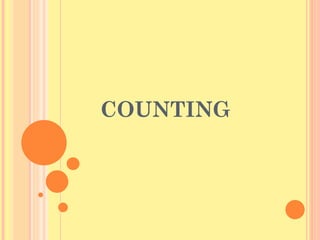Recommended
Recommended
More Related Content
What's hot
What's hot (20)
Problems Involving Probabilities of Events (Math 8)

Problems Involving Probabilities of Events (Math 8)
Similar to Counting
Similar to Counting (20)
statiscs and probability math college to help student

statiscs and probability math college to help student
Recently uploaded
God is a creative God Gen 1:1. All that He created was “good”, could also be translated “beautiful”. God created man in His own image Gen 1:27. Maths helps us discover the beauty that God has created in His world and, in turn, create beautiful designs to serve and enrich the lives of others.
Explore beautiful and ugly buildings. Mathematics helps us create beautiful d...

Explore beautiful and ugly buildings. Mathematics helps us create beautiful d...christianmathematics
https://app.box.com/s/7hlvjxjalkrik7fb082xx3jk7xd7liz3TỔNG ÔN TẬP THI VÀO LỚP 10 MÔN TIẾNG ANH NĂM HỌC 2023 - 2024 CÓ ĐÁP ÁN (NGỮ Â...

TỔNG ÔN TẬP THI VÀO LỚP 10 MÔN TIẾNG ANH NĂM HỌC 2023 - 2024 CÓ ĐÁP ÁN (NGỮ Â...Nguyen Thanh Tu Collection
Recently uploaded (20)
General Principles of Intellectual Property: Concepts of Intellectual Proper...

General Principles of Intellectual Property: Concepts of Intellectual Proper...
Explore beautiful and ugly buildings. Mathematics helps us create beautiful d...

Explore beautiful and ugly buildings. Mathematics helps us create beautiful d...
Unit-V; Pricing (Pharma Marketing Management).pptx

Unit-V; Pricing (Pharma Marketing Management).pptx
On National Teacher Day, meet the 2024-25 Kenan Fellows

On National Teacher Day, meet the 2024-25 Kenan Fellows
This PowerPoint helps students to consider the concept of infinity.

This PowerPoint helps students to consider the concept of infinity.
Presentation by Andreas Schleicher Tackling the School Absenteeism Crisis 30 ...

Presentation by Andreas Schleicher Tackling the School Absenteeism Crisis 30 ...
TỔNG ÔN TẬP THI VÀO LỚP 10 MÔN TIẾNG ANH NĂM HỌC 2023 - 2024 CÓ ĐÁP ÁN (NGỮ Â...

TỔNG ÔN TẬP THI VÀO LỚP 10 MÔN TIẾNG ANH NĂM HỌC 2023 - 2024 CÓ ĐÁP ÁN (NGỮ Â...
Web & Social Media Analytics Previous Year Question Paper.pdf

Web & Social Media Analytics Previous Year Question Paper.pdf
Asian American Pacific Islander Month DDSD 2024.pptx

Asian American Pacific Islander Month DDSD 2024.pptx
Counting
- 1. COUNTING
- 4. THE FUNDAMENTAL PRINCIPLE OF COUNTING Let us help the student who is taking a true-or-false test find the different patterns in answering the ten questions. Before trying to answer these questions, let us consider first a much simpler one. Instead of considering the ten questions, let us limit ourselves to just three questions. In how many ways can the three questions be answered? The different ways of answering them are shown on the diagram. It is called tree diagram because it consists of clusters of line segments or branches.
- 5. EXAMPLE 1
- 7. The diagram shows that there are eight ways in which the three questions can be answered. Examining the diagram, we can arrive at the answer by multiplying the number of ways of answering the first question, 2, by the number of ways of answering the second question, 2, by the number of ways of asnwering the third question, 2: 2 x 2 x 2 = 8
- 8. The tree diagram method can be applied to all problems, but it is very time-consuming and impractical if we are dealing with a series of decisions, each of which contains numerous choices. Going back to our questions for a true-or-false test of ten questions, we can obtain the number of ways of answering it by following the same procedure. 2 x 2 x 2 x 2 x 2 x 2 x 2 x 2 x2x2= 1 024 There are 1 024 ways .
- 9. EXAMPLE 2
- 15. The grid table shows a pairing of numbers from the 2 dice. For example, (1,1) means that the first number,1, is the number on the red die and the second number,1, is the number on the green die; (4,5) means that the first number, 4, is the number on the red die and the second number, 5, is the number on the green die. Notice that these pairs of number are the intersections of a red die and a green die. If the pairs in the list are counted, 36 pairs (6x6 array of number pairs) consisting of red and green dice can be identified. Can you try apply this method on the example 2?
- 17. EXERCISES Answer the following problems using our chosen method of counting.
- 28. THANK YOU! Submitted by: Tadle, Frauline C. Hilado, Sandra Lorraine G. Sarno, Jerome S. Virtudazo, Jeanne Maika T Solis, Edelmiro O. Guerrero, Riann Q.
